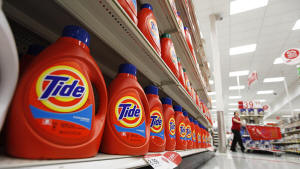Pampers maker Procter & Gamble to cut up to 7,000 jobs as companies are
buffeted by higher costs
[June 06, 2025] By
MICHELLE CHAPMAN
Procter & Gamble will cut up to 7,000 jobs over the next two years as
the maker of Tide detergent and Pampers diapers implements a
restructuring program at a time when tariffs are raising costs for
American companies and consumers are growing anxious about the economy.
The job cuts, announced at the Deutsche Bank Consumer Conference in
Paris on Thursday, make up approximately 6% of the company's global
workforce, or about 15% of its nonmanufacturing positions, said Chief
Financial Officer Andre Schulten.
“This restructuring program is an important step toward ensuring our
ability to deliver our long-term algorithm over the coming two to three
years,” Schulten said. “It does not, however, remove the near-term
challenges that we currently face.”
Procter & Gamble, based in Cincinnati, had approximately 108,000
employees worldwide in June 2024.
The cuts are part of a broader restructuring program. Procter & Gamble
will also end sales of some of its products in certain markets. Procter
& Gamble said it will provide more details about that in July.

Like many companies, Procter & Gamble is dealing with American consumers
who are worrying about their spending as they keep an eye on inflation.
U.S. consumer sentiment fell slightly in May for the fifth straight
month, surprising economists. The preliminary reading of the University
of Michigan’s closely watched consumer sentiment index declined 2.7% on
a monthly basis to 50.8, the second-lowest level in the nearly 75-year
history of the survey. The only lower reading was in June 2022. Since
January, sentiment has tumbled nearly 30%.
[to top of second column] |

In this April 27, 2011 file photo, bottles of Procter & Gamble's
Tide detergent are on display at a Target store in Richmond, Va. (AP
Photo/Steve Helber, File)
 And on Wednesday the Congressional
Budget Office released an analysis that said that President Donald
Trump’s sweeping tariff plan would cut deficits by $2.8 trillion
over a 10-year period while shrinking the economy, raising the
inflation rate and reducing the purchasing power of households
overall.
Baked into the CBO analysis is a prediction that households would
ultimately buy less from countries hit with added tariffs. The
budget office estimates that the tariffs would increase the average
annual rate of inflation by 0.4 percentage points in 2025 and 2026.
In April Procter & Gamble noted during a conference call that the
biggest U.S. tariff impacts were coming from raw and packaging
materials and some finished product sourced from China. The company
said that it would be looking at sourcing options and productivity
improvements to mitigate the tariff impact, but that it may also
have to raise prices on some products.
That same month, the Consumer Brands Association, which represents
big food companies like Coca-Cola and General Mills as well as
consumer product makers like Procter & Gamble, warned that although
its businesses make most of their goods in the U.S., they now face
tariffs on critical ingredients — like wood pulp for toilet paper or
cinnamon — that must be imported because of domestic scarcity.
All contents © copyright 2025 Associated Press. All rights reserved |